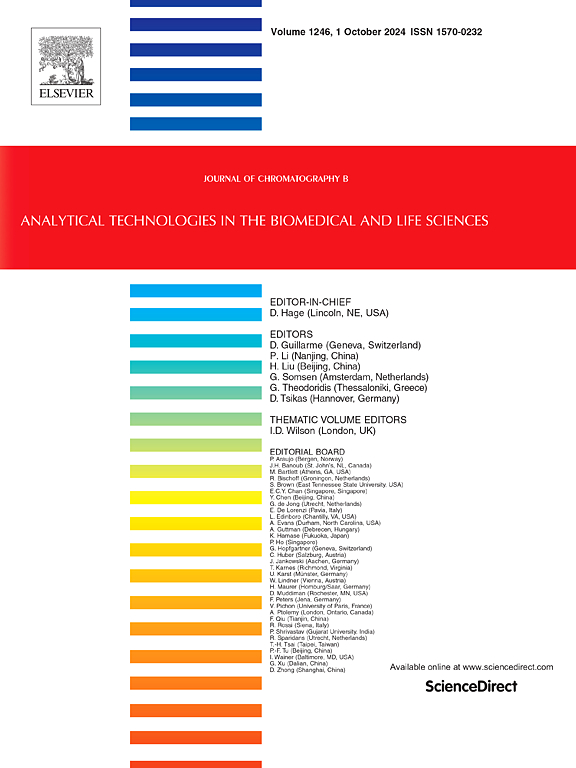Development and validation of an analytical method for metabolites of the plasticizer tri-(2-ethylhexyl) trimellitate (TOTM) in human urine by LC-MS/MS
IF 2.8
3区 医学
Q2 BIOCHEMICAL RESEARCH METHODS
引用次数: 0
Abstract
Tri-(2-ethylhexyl) trimellitate (TEHTM or TOTM) is an alternative plasticizer used as replacement for conventional phthalates, such as bis-(2-ethyl-hexyl) phthalate (DEHP) in plastic materials. Migration studies show a lower leaching potential from the polymer matrix, compared to DEHP. Additionally, toxicological studies showed lower negative health effects of TOTM. A sensitive bioanalytical method is necessary to further enable the exposure assessment of TOTM. In this study, we developed a quantitative method based on SPE and LC-MS/MS for analysis of ten urinary metabolites of TOTM, such as 1,4-di-(2-ethylhexyl) trimellitate (1,4-DEHTM), 2,4-di-(2-ethylhexyl) trimellitate (2,4-DEHTM), 1-mono-(2-ethylhexyl) trimellitate (1-MEHTM), 2-mono-(2-ethylhexyl) trimellitate (2-MEHTM), 1-mono-(2-ethyl-5-carboxypentyl) trimellitate (5Cx-1-MEPTM), 2-mono-(2-ethyl-5-carboxypentyl) trimellitate (5Cx-2-MEPTM), 2-mono-(2-ethyl-5-hydroxyhexyl) trimellitate (5OH-2-MEHTM), and 1-mono-(2-ethyl-5-hydroxyhexyl) trimellitate (5OH-1-MEHTM), and 1-mono-(2-carboxymethylhexyl) trimellitate (2Cx-MMHTM). The method was validated according to the current ‘Bioanalytical Method Validation guidelines’ from European Medicines Agency (EMA). All validation criteria were successfully passed, except for 2Cx-MMHTM and 5Cx-2-MEPTM, which were discarded due to unsatisfactory validation results and low clinical relevance. Additionally, 1,4- and 2,4-DEHTM were successfully validated as a sum of two isomers. The validated method was applied to a pilot set of 30 urine samples from newborn patients. Significant higher urinary concentrations were found for 5Cx-1-MEPTM, 5OH-1-MEHTM, 5OH-2-MEHTM, 5oxo-1-MEHTM and 2-MEHTM in prematurely born babies from the neonatal intensive care unit (NICU) compared to term-born newborns. The current study expanded the range of analytes to eight TOTM metabolites which can be simultaneously analysed in urine samples. It also showed its clinical importance by analysing urine samples from newborns admitted to the NICU.
LC-MS/MS分析人尿中增塑剂三-(2-乙基己基)三甲基酸酯(TOTM)代谢产物的方法的建立与验证
三(2-乙基己基)三甲基酸盐(TEHTM或TOTM)是一种替代塑料材料中的传统邻苯二甲酸酯(如二(2-乙基己基)邻苯二甲酸酯(DEHP))的增塑剂。迁移研究表明,与DEHP相比,聚合物基质的浸出潜力较低。此外,毒理学研究表明,TOTM对健康的负面影响较小。需要一种灵敏的生物分析方法来进一步进行TOTM的暴露评估。本研究建立了一种基于固相萃取和LC-MS/MS的尿代谢产物——1,4-二(2-乙基己基)三ellitate (1,4- dehtm)、2,4-二(2-乙基己基)三ellitate (2,4- dehtm)、1-单(2-乙基己基)三ellitate (1- mehtm)、2-单(2-乙基己基)三ellitate (2- mehtm)、1-单(2-乙基-5-羧戊基)三ellitate (5Cx-1-MEPTM)、2-单(2-乙基-5-羧戊基)三ellitate (5Cx-2-MEPTM)、2-单-(2-乙基-5-羟己基)三卫星酸酯(5OH-2-MEHTM)、1-单-(2-乙基-5-羟己基)三卫星酸酯(5OH-1-MEHTM)和1-单(2-羧甲基己基)三卫星酸酯(2Cx-MMHTM)。该方法根据欧洲药品管理局(EMA)现行的“生物分析方法验证指南”进行了验证。除2x - mmhtm和5x -2- meptm因验证结果不理想、临床相关性低而被丢弃外,其余验证标准均顺利通过。此外,1,4-和2,4- dehtm被成功地验证为两个异构体的总和。将该方法应用于30例新生儿尿液样本的试验集。新生儿重症监护病房(NICU)早产儿尿中5x -1- meptm、5OH-1-MEHTM、5OH-2-MEHTM、5oxo-1-MEHTM和2-MEHTM浓度显著高于足月新生儿。目前的研究将分析物的范围扩大到八种TOTM代谢物,可以同时在尿液样本中分析。通过分析新生儿入住NICU的尿液样本也显示了它的临床重要性。
本文章由计算机程序翻译,如有差异,请以英文原文为准。
求助全文
约1分钟内获得全文
求助全文
来源期刊

Journal of Chromatography B
医学-分析化学
CiteScore
5.60
自引率
3.30%
发文量
306
审稿时长
44 days
期刊介绍:
The Journal of Chromatography B publishes papers on developments in separation science relevant to biology and biomedical research including both fundamental advances and applications. Analytical techniques which may be considered include the various facets of chromatography, electrophoresis and related methods, affinity and immunoaffinity-based methodologies, hyphenated and other multi-dimensional techniques, and microanalytical approaches. The journal also considers articles reporting developments in sample preparation, detection techniques including mass spectrometry, and data handling and analysis.
Developments related to preparative separations for the isolation and purification of components of biological systems may be published, including chromatographic and electrophoretic methods, affinity separations, field flow fractionation and other preparative approaches.
Applications to the analysis of biological systems and samples will be considered when the analytical science contains a significant element of novelty, e.g. a new approach to the separation of a compound, novel combination of analytical techniques, or significantly improved analytical performance.
 求助内容:
求助内容: 应助结果提醒方式:
应助结果提醒方式:


